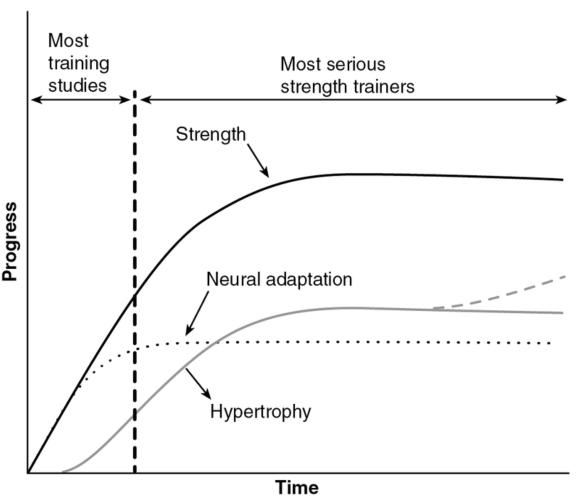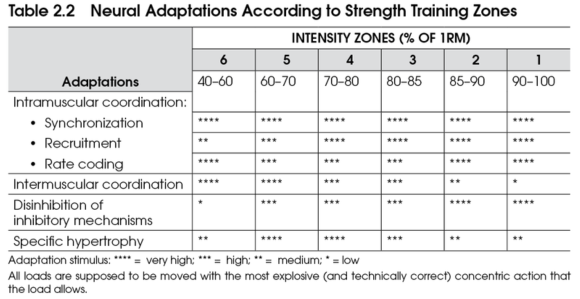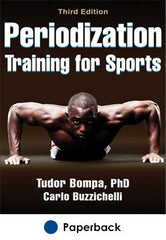Neuromuscular adaptations to strength training
This is an excerpt from Periodization Training for Sports-3rd Edition by Tudor Bompa & Carlo Buzzichelli.
Strength Training and Neuromuscular Adaptations
Systematic strength training produces structural and functional changes, or adaptations, in the body. The level of adaptation is evidenced by the size and strength of the muscles. The magnitude of these adaptations is directly proportional to the demands placed on the body by the volume (quantity), frequency, and intensity (load) of training, as well as the body's capability to adapt to such demands. Training rationally adapts to the stress of increasing physical work. In other words, if the body is presented with a demand rationally greater than it is accustomed to and enough recovery time is given to trained physiological systems, it adapts to the stressor by becoming stronger.
Until a few years ago, we believed that strength was determined mainly by the muscles' cross-sectional area (CSA). As a result, weight training was used to increase "engine size" - that is, to produce muscular hypertrophy. However, though CSA is the single best predictor of an individual's strength (Lamb 1984), strength training research since the 1980s (and authors such as Zatsiorsky and Bompa) have shifted the focus to the neural component of strength expression. In fact, the primary role of the nervous system in strength expression was well documented by a 2001 review (Broughton).
Neural adaptations to strength training involve disinhibition of inhibitory mechanisms, as well as intra- and intermuscular coordination improvements. Disinhibition affects the following mechanisms:
- Golgi tendon organs - sensory receptors, located near the myotendinous junction, that elicit a reflex inhibition of the muscle they supply when it undergoes excessive tension, either by shortening or passive stretching
- Renshaw cells - inhibitory connecting neurons (interneurons) found in the spinal cord, whose role is to dampen the rate of discharge of alpha motor neurons, thus preventing the muscular damage derived from tetanic contraction
- Supraspinal inhibitory signals - conscious or unconscious inhibitory signals that come from the brain
The components of intramuscular coordination are as follows:
- Synchronization - the capacity to contract motor units simultaneously or with a minimum latency (that is, with a delay less than five milliseconds)
- Recruitment - the capacity to recruit motor units simultaneously
- Rate coding - the capacity to increase firing rate (motor unit discharge rate) in order to express more strength
Adaptations in intramuscular coordination transfer well from one exercise to another, as long as the specific motor pattern is established (intermuscular coordination). For instance, the maximum voluntary recruitment of motor units developed through maximum strength training can be transferred to a sport-specific exercise skill as long as its technique is known by the athlete. The objective of maximum strength macrocycles is to improve motor unit recruitment of the prime movers, whereas power macrocycles work mainly on rate coding. Contrary to popular belief, these two aspects of intramuscular coordination - recruitment and rate coding - play greater determinant roles than synchronization does in muscular force production.
Intermuscular coordination, on the other hand, is the capacity of the nervous system to coordinate the "rings" of the kinetic chain, thus making the gesture more efficient. With time, as the nervous system learns the gesture, fewer motor units get activated by the same weight, which leaves more motor units available for activation by higher weights (see figure 2.5, a and b). Therefore, to increase the weight lifted in a given exercise over the long term, intermuscular coordination training (technique training) is the key. Nevertheless, intermuscular coordination is very exercise specific, so its transfer to other exercises (including sport-specific ones) is very limited. Even so, it remains the base for the athlete's general strength development.


Over time, strength training for intermuscular coordination reduces the motor unit activation necessary to lift the same load, thus leaving more motor units available for higher loads.
Despite the fact that the hypertrophic response to training is immediate (Ploutz, et al. 1994), the accretion of muscular protein becomes evident only after six weeks or more (Moritani and deVries 1979; Rasmussen and Phillips 2003). These proteins, which represent the specific adaptive response to the imposed training, stabilize the achieved neural adaptations. This is the way to read the famous study by Moritani and deVries (see figure 2.6) because the neural adaptations, once they take place, are neither at their full potential nor absolutely stable. Therefore, to increase strength over time, one must keep training the factors discussed here. This is particularly true of intermuscular coordination, which allows load increase in the midterm and the long term on the basis of ever-increasing system efficiency, as well as specific hypertrophy.

Neural and muscular adaptations to strength training over time, according to Moritani and deVries (1979).
Adapted, by permission, from T. Moritani and H.A. deVries, 1979, "Neural factors versus hypertrophy in the time course of muscle strength gain," American Journal of Physical Medicine 58(3):115-130.
For years, Eastern European training methodologists and coaches have been using training intensity zones as brackets of 1RM to design and analyze strength training programs. According to most of the strength training methodology literature, the best training zones to elicit maximum strength gains were zones 2 and 1 (loads from 85 percent and up). In more recent years, the focus has shifted from zone 1 loads (those over 90 percent) to zone 3 loads (those from 70 percent to 80 percent). This shift has occurredon the basis of field experience of weightlifters (except for the Bulgarian and Greek schools and their North American clones, who have used very high intensities very frequently and, not coincidentally, have had a sad story of positive doping tests), as well as Russian and Italian powerlifters. That is, analysis of the best weightlifters' programs (Roman 1986) and powerlifters has shown a concentration of training loads in zone 3. Again, identifying zone 3 as the most important zone for maximum strength development is a fundamental change because almost all classic literature about strength training has indicated that training loads for maximum strength development should be 85 percent of 1RM or higher.
The field has shown us that
- the majority of adaptations of the neuromuscular system necessary to increase maximum strength involve loads lower than 90 percent of 1RM and
- the time of exposure to loads of 90 percent or higher (necessary in order to elicit adaptations specific to that intensity range) should be very short.
Table 2.2 summarizes the neuromuscular adaptations for each intensity range. From this table, we learn that
- the majority of intramuscular coordination gains involve loads over 80 percent;
- the majority of intermuscular coordination gains involve loads under 80 percent; and
- we need to use the full spectrum of intensities to maximize neuromuscular adaptations and, consequently, maximum strength.

From this table, taking into consideration the training methodology, we can infer the following points.
- In a preparation phase with limited time for development of maximum strength - or when the coaching of the same group of athletes will probably last only one season - the average intensities used in the maximum strength macrocycles will be higher (80 percent to 85 percent of 1RM). Thisapproachis usually taken in team sports.
- In the preparation phase for an individual sport with ample time for development of maximum strength - and especially when a multiyear perspective projects continuous progression in the midterm and long term - the periodized strength plan will focus mostly on intermuscular coordination. Thus the average, not the peak, intensities used in maximum strength macrocycles will be lower (70 percent to 80 percent of 1RM).
- Nevertheless, for the development of maximum strength, every periodized plan starts with lower intensities, higher times under tension per set (which favor the anatomical adaptations), and a focus on technique so that higher intensities will elicit high muscular tension later on.
Because different types of adaptation can occur, periodization of strength offers a seven-phase approach that follows the physiological rhythm of the neuromuscular system's response to strength training. The seven phases are anatomical adaptation, hypertrophy, maximum strength, conversion, maintenance, cessation, and compensation. Depending on the physiological demands of the sport, the periodization of strength involves combining, in sequence, at least four of the phases: anatomical adaptation, maximum strength, conversion to specific strength, and maintenance. All models for periodization of strength begin with an anatomical adaptation phase. Five of the seven possible phases are discussed briefly in the following paragraphs. The remaining two phases - to be used during the taper and transition periods - are discussed in later chapters.
Learn more about Periodization Training for Sports, Third Edition.
More Excerpts From Periodization Training for Sports-3rd Edition

Get the latest insights with regular newsletters, plus periodic product information and special insider offers.
JOIN NOW


